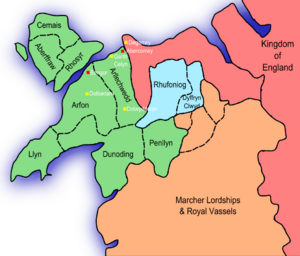Treaty of Aberconwy facts for kids
The Treaty of Aberconwy was an important agreement signed on November 10, 1277. It was made between King Edward I of England and Llewelyn the Last, who was the Prince of Wales. This treaty brought peace after King Edward had invaded Llywelyn's lands earlier that year. However, it also meant that Wales would likely lose its independence when Llywelyn died. It was a big step in King Edward's plan to take over Wales.
Contents
Why the Treaty Happened
A Royal Marriage and a King's Fear
Llywelyn wanted to strengthen his connection to royal families. He planned to marry Eleanor de Montfort. She was the daughter of Simon de Montfort and a cousin of King Edward. They got married by proxy in 1275, meaning someone stood in for Llywelyn at the ceremony.
However, when Eleanor sailed from France to meet Llywelyn, King Edward had a plan. He hired pirates to capture her ship. Eleanor was then held prisoner at Windsor Castle.
King Edward's Concerns
King Edward had just become the King of England. He saw Llywelyn as a threat to his power. Edward especially did not like the idea of Llywelyn marrying Eleanor. Her father, Simon de Montfort, had been a big challenge to the previous English king.
King Edward also asked Llywelyn to come and meet him several times. Llywelyn refused to go. He felt it was not safe for him at King Edward's court.
The Invasion of Wales
In 1276, King Edward declared Llywelyn a rebel. This meant Llywelyn was seen as someone going against the king. Edward then gathered a very large army to march against him.
By the summer of 1277, Edward's soldiers had reached the heart of Gwynedd. This was Llywelyn's main territory in Wales. Edward's men took all the crops in Anglesey. This left Llywelyn and his men without food. Because of this, Llywelyn was forced to give up and surrender.
What the Treaty Said
New Borders and Power Changes
The Treaty of Aberconwy brought peace to Gwynedd. But Llywelyn had to agree to several difficult conditions. His power was limited to lands west of the River Conwy. The lands east of the river were given to his brother, Dafydd ap Gruffydd. Llywelyn and Dafydd had fought each other for control of Wales before.
Llywelyn kept his title, Prince of Wales. However, most of the smaller Welsh rulers who had been loyal to him no longer had to recognize him as their lord. This greatly reduced his influence.
Building Fortresses
After the treaty was signed, King Edward started building many strong castles. These fortresses were built along the routes leading into Gwynedd. Some of these castles were at Aberystwyth, Builth, Flint, and Rhuddlan. The treaty was agreed upon on November 9, 1277, and King Edward officially approved it on November 10, 1277.
What Happened After
In the years following the treaty, Llywelyn tried to make the most of the power he had left. He showed respect and paid money to King Edward. In return, King Edward allowed Llywelyn's marriage to Eleanor to go ahead. In 1278, Llywelyn and Eleanor de Montfort were married in Worcester Cathedral. King Edward himself was there to see the wedding.
See also
- List of treaties


